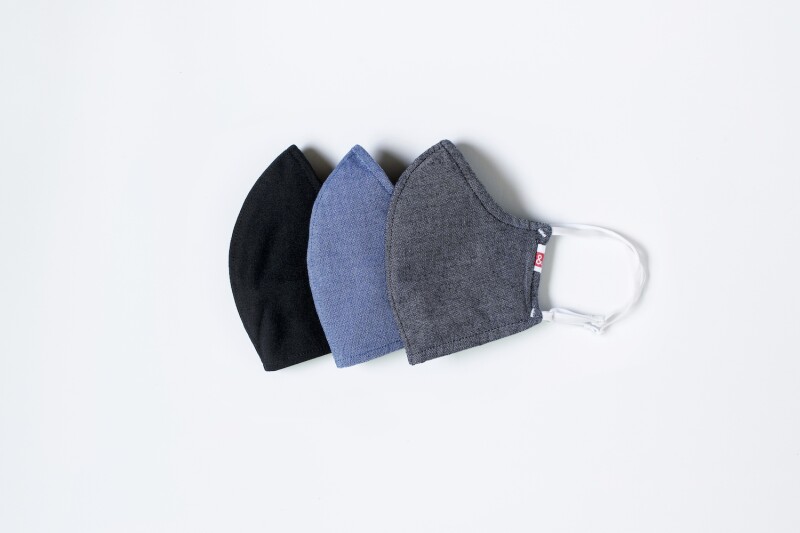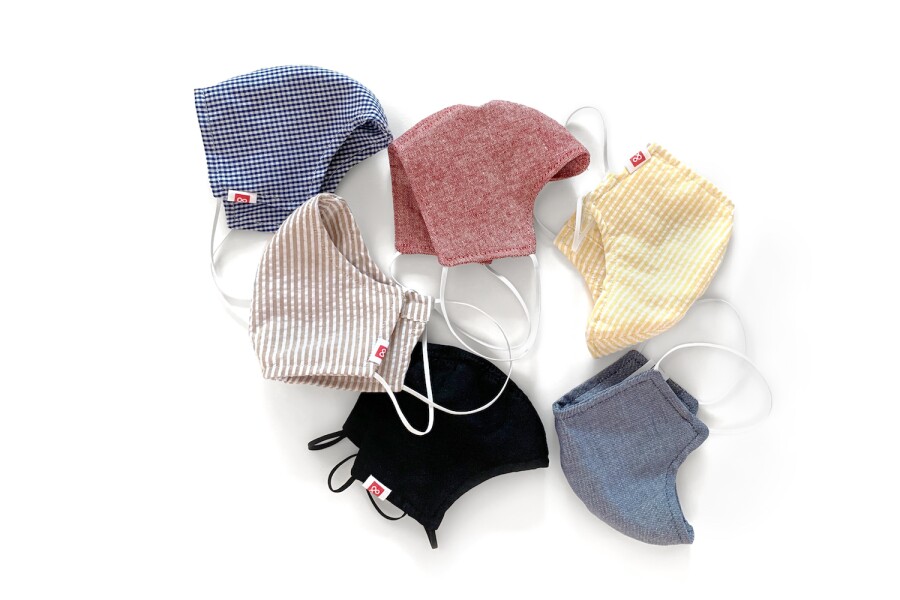The U.S. Centers for Disease Control and Prevention (CDC) has some new advice when it comes to masking up—wear a mask that fits snugly made of multiple layers of fabric or double up on masks.
“Not all masks provide the same protection,” the CDC states in its updated mask guidance, which it released on February 10. “When choosing a mask, look at how well it fits, how well it filters the air, and how many layers it has.”
The agency’s latest advice on mask wearing to help prevent the spread of COVID-19 is based on the results of a new CDC study that found that exposure to potentially infectious aerosols decreased by 95 percent when tightly fitted or double masks were worn.
Based on the findings there are several ways we can wear our masks that will better protect us from transmission. That includes making sure your mask fits snugly against your face—any gaps offer an opportunity for respiratory droplets to get in or out of the mask.
You will also be better protected if your mask either has multiple layers of fabric or if you double up by wearing a disposable mask underneath a snug cloth mask.
“Appropriately worn masks reduce the spread of COVID-19,” the CDC states. The agency notes that masks help prevent transmission of virus droplets exhaled by those who have COVID-19, including those who are not symptomatic—it’s estimated that presymptomatic or asymptomatic transmissions account for more than 50 percent of all transmissions.
“Masks also provide personal protection to the wearer by reducing inhalation of these droplets,” the CDC states.
Children under the age of two should not wear a face mask, nor should anyone with a disability that prohibits them from wearing a mask.
Note that masks are not meant to replace social distancing and additional public health measures that have also been put in place to mitigate the spread of COVID-19. They are meant to be an added line of defense.
Where are masks required?
Wearing masks is now mandatory in all transportation hubs and on all public modes of transportation, according to a new order issued by the CDC.
The order is effective as of February 2, 2021, and remains in effect until further notice. It makes official a mask mandate that was signed by President Joe Biden on January 21, marking the first time the U.S. federal government established an official directive on mask wearing during the coronavirus pandemic.
According to the CDC directive, masks are now required on and in airplanes, ships, ferries, trains, subways, buses, taxis, and rideshares traveling into, within, and out of the United States. They are also required in the country’s transportation hubs, including airports and seaports and train, bus, and subway stations.
Those who don’t comply with the order could be fined of up to $1,500 by the U.S. Transportation Security Administration (TSA). TSA said it will require individuals to wear a mask at TSA checkpoints and throughout commercial and public transportation systems until May 11, 2021. Passengers without a mask may also be denied entry, boarding, or continued transport, the agency stated. Those who refuse to wear a mask can be fined anywhere from $250 for a first offense up to $1,500 for repeat offenders.
President Biden has also signed an Executive Order on Protecting the Federal Workforce and Requiring Mask-Wearing that applies to federal employees, buildings, and lands. Federal lands include the country’s National Park System, a network of 423 national parks, monuments, memorials, historic sites, and nature reserves.
All major U.S. airlines have already been requiring passengers to wear face masks since May—and travelers could be prohibited from flying or have their flying privileges revoked if they don’t comply. International carriers require masks as well. You should check with your airline for what the latest requirements are before flying, including specific types of masks that are and are not allowed on your flight.
Masks can be briefly removed while eating, drinking, or taking medication; to verify someone’s identity such as during TSA airport screenings; and when oxygen masks are required on an aircraft.
What kind of masks does the CDC say we should wear?
The CDC now recommends that we wear a mask that fits snugly with multiple layers of fabric, or that we double up on masks.
For those wearing cloth masks, the masks “should be made with two or more layers of a breathable fabric that is tightly woven (i.e., fabrics that do not let light pass through when held up to a light source)”—that goes for gaiters, too, which should have two layers of fabric or be folded into two layers, according to the agency.
You can also wear a disposable or surgical mask underneath a snug cloth mask.
N95 respirator masks also pass muster—though the agency asks that we try to reserve these masks for health-care workers so that we don’t deplete the supplies for those who are in direct contact with COVID-19 patients and thus are at the highest risk of exposure.
According to the CDC, these masks or face coverings do not meet the agency’s mask requirements:
- Face shields
- Scarves, ski masks, balaclavas, or bandannas (if these need to be worn for warmth, they should be worn over the mask, not in lieu of one)
- Turtleneck collars pulled up over the mouth and nose
- Masks containing slits, valves, or punctures
How to properly wear a mask
In order for a mask to be effective, it needs to be worn properly. It should cover your mouth and nose area and stretch from just below your eyes to down under your chin. On the sides, it should cover about half of your cheek area, the CDC advises. It should fit snugly but comfortably and be secured by being tied behind your head or looped around your ears. It should allow for easy breathing.
If you are wearing two masks, the second or top layer mask should push the edges of the inner mask against your face.
The CDC also recommends using a mask fitter or brace, such as this one, over a disposable mask or a cloth mask to help better secure the mask and prevent air leakage. You can also knot the ear loops to get the mask to fit more securely on your face.
For masks with nose wires, the nose wire should be bent over your nose so that the mask fits close to your face.
You can check for gaps in your mask by cupping your hands around the outside edges of the mask and making sure there is no air flowing out of the top of the mask toward your eyes or out of the sides. You should, however, be able to breathe comfortably and feel warm air coming through the front of the mask and even see the mask move a bit with each breath.
Cloth face masks should be washed regularly (throwing them in the washing machine will suffice, according to the CDC), and when you remove them you should take care not to touch your eyes, nose, or mouth and wash your hands immediately after.
The best face masks for travel
There are countless companies now making face masks, and the best part is that many of the companies that have rushed to fill the mask void are donating proceeds to organizations working to fight the coronavirus pandemic or to those in need—some are even supplying masks in kind to health-care and frontline workers. Here are some of the masks we’ve come across that we love, both in look and mission.

The Summersalt face coverings come in a variety of colors and patterns.
Courtesy of Summersalt
Summersalt face coverings
Buy Now: $32 for a three-pack, summersalt.com
Several AFAR staffers own these simple but super cute masks from St. Louis–based sustainable swimwear brand Summersalt, and they get unanimous approval. The style and fit (catered more to women) make them very versatile—they would be great on a plane or train or around town. The inside layer is cotton, and the outer layer is a mix of recycled polyamide and elastane (or what we would call “swimsuit-y” material). They are reusable and machine washable and most importantly have adjustable ear loops for an ideal fit. For every set sold, Summersalt will donate a mask to a “worthy organization”—and it has asked patrons to suggest groups that could benefit (you can DM the company on Instagram @summersalt with a recommendation).
Marine Layer super-soft masks
Buy Now: $14 (was $25) for a five-pack, marinelayer.com
The San Francisco–based purveyor of super-soft tees is making masks from two layers of its trademark addictively soft fabric. These are the tie-back kind (better as backups than for everyday use) and come with a filter pocket. The colors vary. They also sell sports masks made from a stretchy, quick-drying fabric and constructed with adjustable over-the-ear loops.

These classic masks were recently upgraded with adjustable ear loops.
Courtesy of Hedley & Bennett
Hedley & Bennett’s Wake Up and Fight masks
Buy Now: $15, hedleyandbennett.com
In the wake of the coronavirus pandemic, this Vernon, California–based manufacturer of must-have aprons switched production gears to make face masks. These are washable and reusable, nonsurgical cotton masks with a filter insert. The ear loops are adjustable, and we can attest that these are extremely durable, versatile, and well-fitting masks.
For Days double-layer cotton masks
Buy Now: $12 (was $25) for a five-pack, fordays.com
The Los Angeles–based zero-waste clothing company For Days is selling five-packs of reusable double-layer organic cotton masks. The masks have a pocket for a filter to be added if preferred and are outfitted with elastic loops that go over the ears. These solid unisex masks are great for every day.

Uniqlo AIRism Face Masks feature three layers.
Courtesy of Uniqlo
Uniqlo AIRism face masks
Buy Now: $15 for a three-pack, uniqlo.com
These Uniqlo face masks are made from an anti-microbial AIRism fabric that wicks away moisture and comes with a UPF 40 to block 90 percent of ultraviolet rays, making these great for bike-riding, running, hiking, or other outdoor activities. Each mask features triple-layer construction with a built-in filter at the center that retains its efficacy even after going through a machine washer. Available in multiple colors, these masks come in four sizes to fit both children and adults.

The Evolvetogether disposable face masks come in black, green, and white.
Courtesy of Evolvetogether
Evolvetogether disposable face masks
Buy Now: $9 for a seven-pack, evolvetogether.com
If you’re looking for a more stylish alternative to the basic blue disposable face masks, Evolvetogether makes them in several different colors. These masks feature soft ear loops, an adjustable nose bridge for a secure fit, and three layers, including a water-resistant outer layer, a melt blown center, and a water absorbent inner layer. These masks also come in olive green, navy, and are also sold in 30-packs and kid sizes.
Handmade masks
Buy Now: Prices vary, etsy.com
Support small businesses and local entrepreneurs by buying a homemade mask on Etsy. We love the simple but sweet patterns on these organic cotton fleece masks.
This article originally appeared on January 24, 2020, and was updated on February 10, 2021, to include current information.
>> Next: 10 Comfy Pants That Are Perfect for Both WFH and Long Flights








